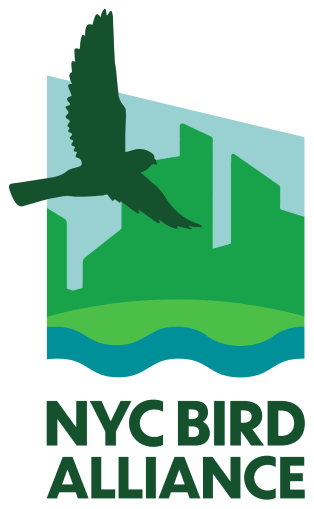Brooklyn HotspotsClick on a park below to see it on the map.
American Veterans Memorial Pier
Brooklyn Botanic Garden
Brooklyn Bridge Park
Bush Terminal Piers Park
Calvert Vaux Park
Canarsie Park
Coney Island Beach and Pier
Coney Island Creek Park
Dead Horse Bay
Floyd Bennett Field
Gravesend Bay/Shore Parkway
Green-Wood Cemetery
Leon S. Kaiser Park
Manhattan Beach Park
Marine Park Preserve
Owl's Head Park
Plumb Beach
Prospect Park
Ridgewood Reservoir in Highland Park
Sheepshead Bay Piers
Shirley Chisholm State Park
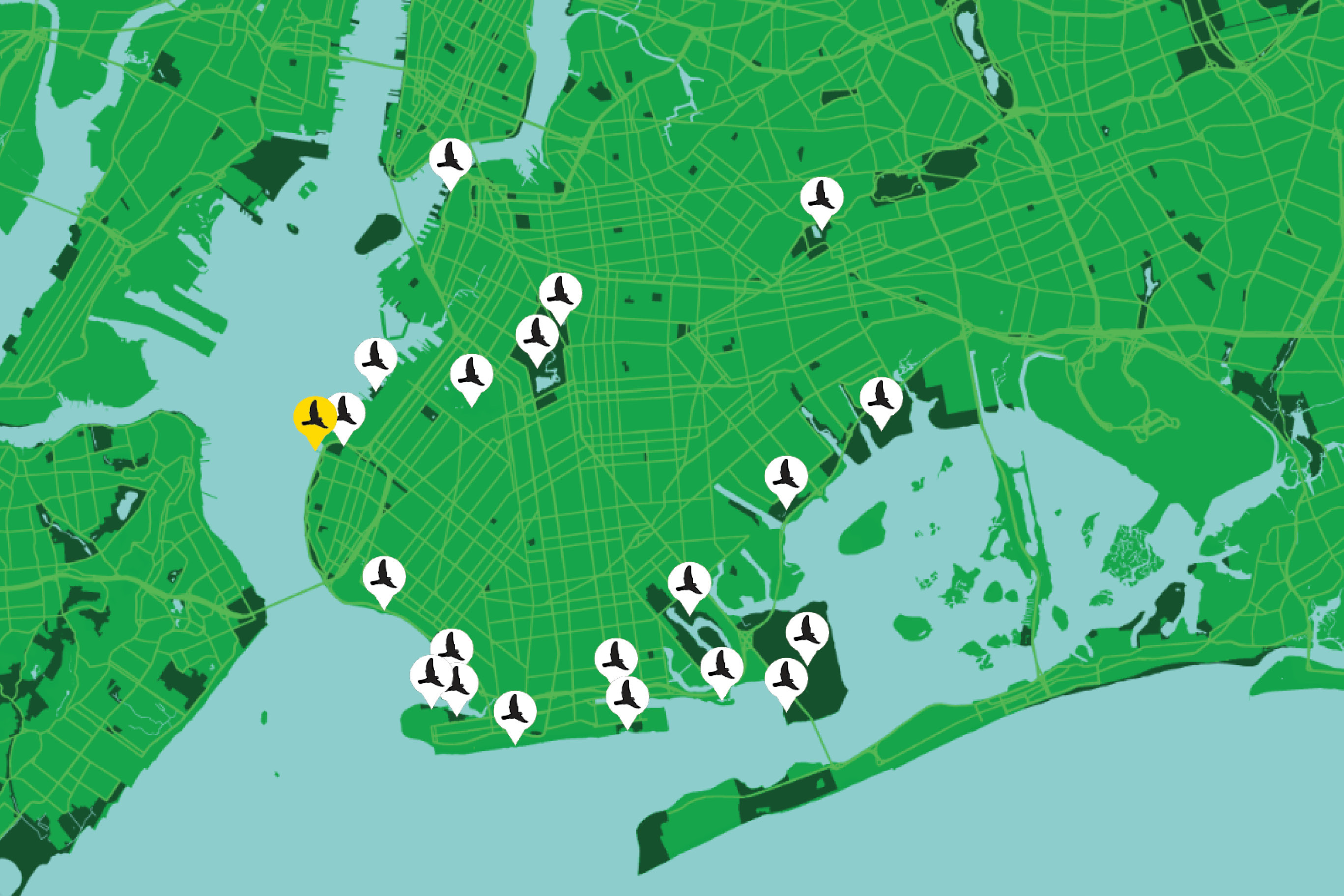
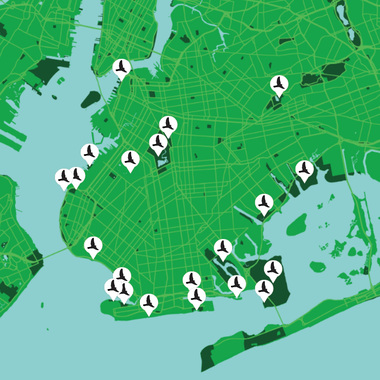
BIRDING IN BROOKLYN
Brooklyn, named after the Dutch village of Breukelen and also known as Kings County, occupies the southwestern end of Long Island. It is the most populous of New York City’s five boroughs, home to over 2.6 million residents. At the heart of this busy borough lie three landscaped parklands: Prospect Park, Brooklyn Botanic Garden, and Green-Wood Cemetery, each of which offers excellent birding all year, and particularly during migration. Other Brooklyn birding opportunities are found along its extensive coastline, which fronts on the East River, New York Bay and the Narrows, and Jamaica Bay. The largest of these are Marine Park Preserve, Floyd Bennett Field, and Shirley Chisholm State Park, but the borough’s western and southern coasts are dotted with many other hotspots including Brooklyn Bridge Park, Calvert Vaux Park, Coney Island Creek, Sheepshead Bay, and Plumb Beach.
Brooklyn has a long birding tradition (the Brooklyn Bird Club was founded in 1909) and is home to a passionate birding population that has recorded over 360 bird species in the borough, according to Brooklyn (Kings County) eBird records. Rarities recorded over the years have included Black-bellied Whistling Duck, Red-billed Tropicbird, Purple Gallinule, Western Reef Heron, Cassin’s Kingbird, Varied Thrush, Bohemian Waxwing, Yellow-headed Blackbird, and Painted Bunting. Brooklyn’s natural spaces also host a startling variety of breeding species: recent nesters have included Green Heron, Ring-necked Pheasant, Clapper Rail, Cooper’s Hawk, Osprey, Monk Parakeet, Acadian Flycatcher, Blue-gray Gnatcatcher, both Baltimore and Orchard Orioles, Indigo Bunting, and Blue Grosbeak.
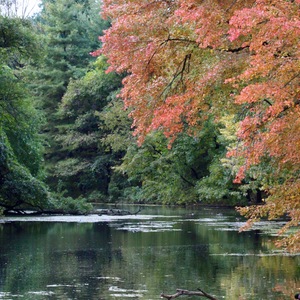
The waterways of Prospect Park offer habitat for many bird species, including breeding Wood Duck and Green Heron. Photo: Ryan F. Mandelbaum
Birding in Prospect Park, Brooklyn
Prospect Park, Brooklyn Botanic Garden, and the adjacent Brooklyn Museum grounds combine to create a contiguous, accessible bird refuge of over 640 acres in Central Brooklyn. This varied habitat of woodlands, gardens, meadows, lakes, and streams is a magnet for migrating birds of all kinds, herons, hawks, owls, waterfowl, and more. eBirders have recorded 290 species in Prospect Park.
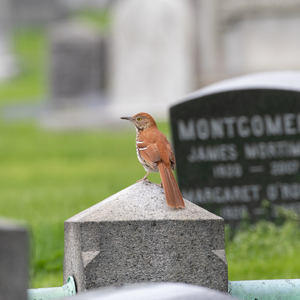
Good views of migrants such as this Brown Thrasher are often available as they stop through the open grounds of Green-Wood Cemetery. Photo: Ryan F. Mandelbaum
Green-Wood Cemetery
A short stroll west from Prospect Park leads to another expansive greenspace popular with both birds and birders: Green-Wood Cemetery. Though the cemetery is especially known to birders for the South American Monk Parakeets that nest upon its gates, its grounds offer a diversity of habitats to many species: mature alleys of trees attract migrant songbirds, while the property’s rolling hills include the highest point in Brooklyn, which provides a vantage point for raptor-watching as well as excellent views of the harbor. Four ponds and the natural habitat surrounding them attract a good variety of waterbirds and other migrants. eBirders have recorded 236 species in Green-Wood Cemetery.
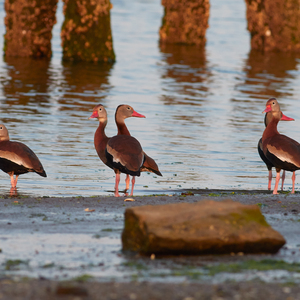
Interesting species can often be found in Marine Park, such as these Black-bellied Whistling Ducks (during an unexpected visit in 2016). Photo: Karen Fung
Marine Park
Brooklyn’s largest park, Marine Park, includes 530 acres of salt marsh, grassland, and maritime forest habitat surrounding the tidal Gerritsen Creek. This habitat forms the “Forever Wild” Marine Park Preserve, and is overseen by the Salt Marsh Nature Center. During breeding season, a well-maintained trail system provides opportunities to see nesting Osprey, as well as secretive marsh-nesting species such as Clapper Rail and Saltmarsh Sparrow. A variety of waterbirds including egrets, herons, terns, and shorebirds forage here, while wooded areas provide good stopover habitat for migrating flycatchers and songbirds. eBirders have recorded over 270 species in Marine Park.
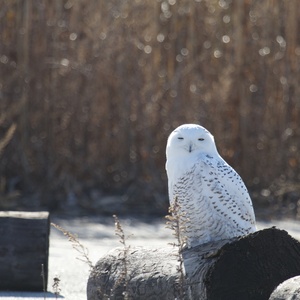
Floyd Bennett Field is one of the best places in New York City to see Snowy Owls. Photo: Heather Wolf/CC BY-NC-SA 2.0
Floyd Bennett Field and Dead Horse Bay
At Brooklyn’s southeast corner, a large, squarish peninsula juts into Jamaica Bay: the manmade habitat of Floyd Bennett Field. Serving originally as New York City’s first municipal airport, the site now provides an unusual preserved grassland habitat in the City, thanks in part to NYC Bird Alliance’s early conservation work. This is the likeliest spot in the City to see wintering Snowy Owl, as well as other grassland species such as Horned Lark, Savannah Sparrow, and Northern Harrier. The park also hosts extensive forest and wetland habitat. eBirders have recorded 283 species in Floyd Bennett Field. (Dead Horse Bay, just west of Floyd Bennett Field, a good spot to find foraging shorebirds and wintering waterfowl, is currently closed to the public.)
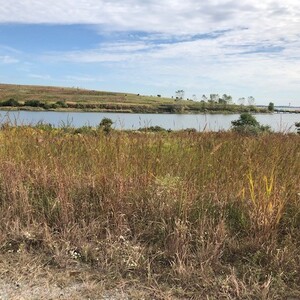
Shirley Chisholm State Park offers a variety of habitat including grasslands, tidal creeks, marsh, and beach. Photo: Karen Benfield
Shirley Chisholm State Park
Brooklyn’s newest park is named after the trail-blazing Shirley Chisholm, the first Black woman elected to the U.S. House of Representatives. This large greenspace overlooking Jamaica Bay spans over 400 acres and hosts 10 miles of walking trails, making it Brooklyn’s third-largest park. It is also one of the City’s more innovative natural spaces: the park joins several other capped landfill parks, such as Staten Island’s Freshkills Park, in providing new habitat for grassland and shrubland bird species. Since the park opened in 2019, eBirders have already recorded over 150 species here, including nesting Ring-necked Pheasant and Blue Grosbeak.

Brooklyn Bridge Park includes varied bird habitat including restored salt marsh and forested upland areas. Photo: Gigi Altarejos
West Brooklyn Coast
Along Brooklyn’s west coast, stretching south from the Brooklyn Bridge to Coney Island, a series of riverside parks are well known in birding circles for the variety of birds spotted throughout the year. Brooklyn Bridge Park, Bush Terminal Piers Park, Owl’s Head Park, Veterans Memorial Pier, and Calvert Vaux Park provide vantage points to view waterbirds on Upper New York Bay and Gravesend Bay, particularly during the winter, and also host a variety of upland and wetland habitats that attract birds throughout the year.
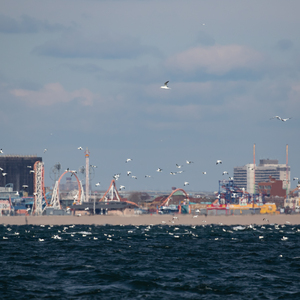
Northern Gannets sometimes gather in great numbers off of Coney Island Beach (here seen from the Rockaway Peninsula with Coney Island in the background). Photo: Ryan F. Mandelbaum
South Brooklyn Coast
Brooklyn’s southernmost border is formed by the long landform of Coney Island, along with some fragments of remaining marshland along Coney Island Creek. Historically consisting of shifting sandbars and salt marsh, this area has been altered by development over several centuries, but still offers varied habitat on both beach and bay sides for shorebirds, waterfowl, and seabirds. From west to east, birding hotspots include Coney Island Creek Park and Leon S. Kaiser Park, Coney Island Beach and Pier, Manhattan Beach Park, Sheepshead Bay, and Plumb Beach.
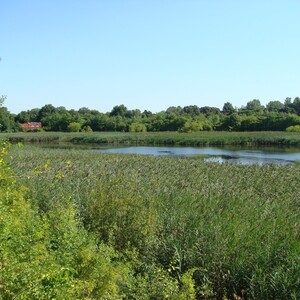
Ridgewood Reservoir's main freshwater basin is a surprisingly wild habitat in western Brooklyn. Photo: Glenn Phillips
More Brooklyn Hotspots
These additional Brooklyn hotspots provide a mixture of habitats for both freshwater and saltwater waterbirds. Ridgewood Reservoir, a rich property of woodland and wetlands on the Brooklyn/Queens borders that is part of Brooklyn's Highland Park, was preserved after years of advocacy by local conservationists. Canarsie Park, on the northern edge of Jamaica Bay, is a preserved park of uplands and salt marsh between Floyd Bennett Field and Shirley Chisholm Park.
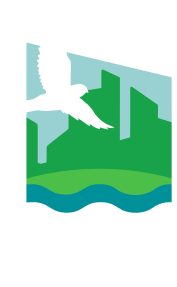
 park locations
park locations